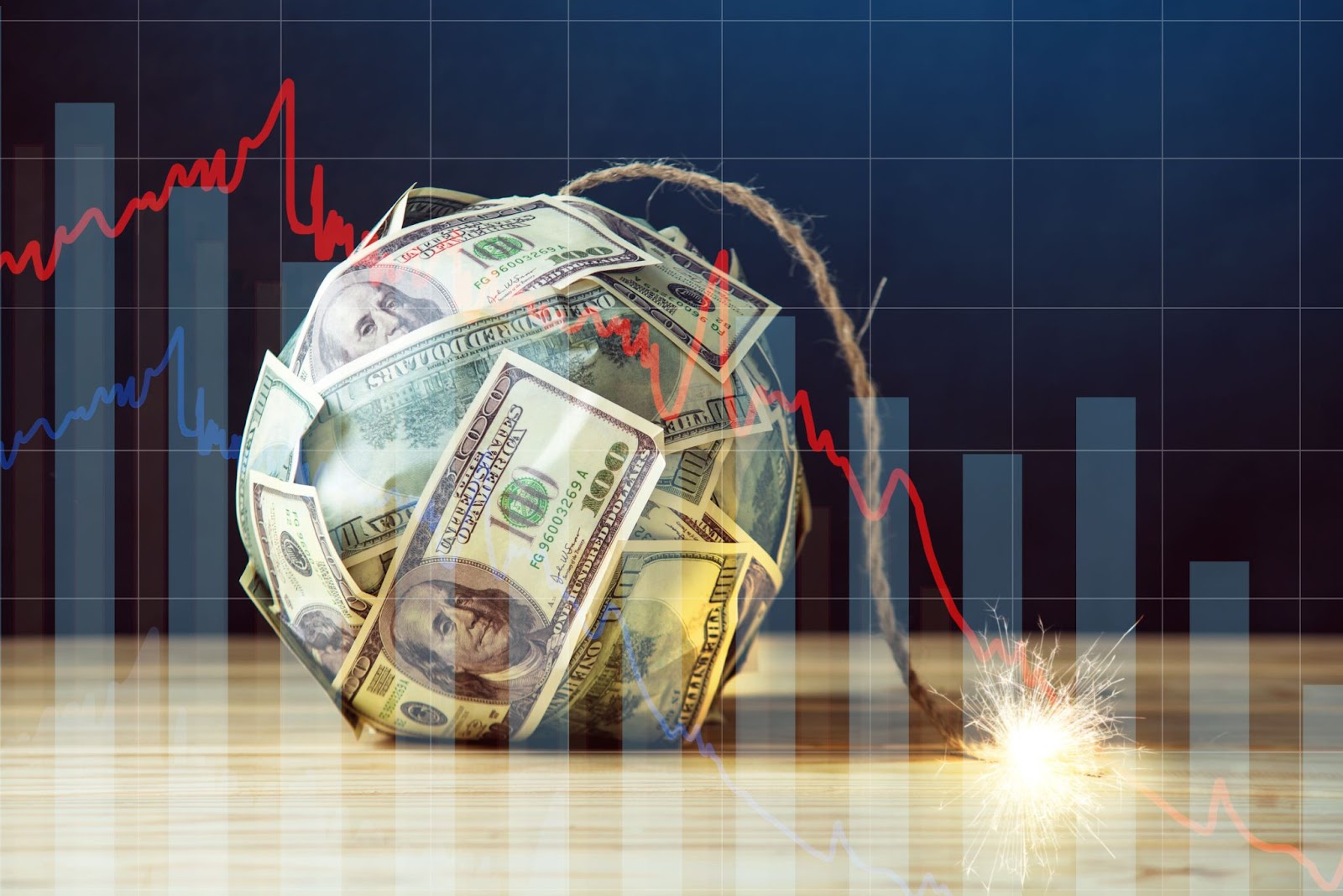A debt crisis occurs when a nation can’t handle its debt, leading to economic instability. This article explores what triggers a debt crisis, its history, current trends, and risks.
Key Takeaways
- A debt crisis arises when a government’s public debt becomes unsustainable, leading to economic instability and creditworthiness issues.
- Current global debt levels have reached $97 trillion, with significant concerns over fiscal sustainability, especially in the U.S. and many African nations.
- Rising national debt entails risks such as increased servicing costs and potential erosion of the dollar’s creditworthiness, necessitating careful fiscal management.
Understanding the Debt Crisis

A debt crisis occurs when a government’s public debt becomes unsustainable relative to its tax revenues. This typically follows prolonged periods of excessive government spending compared to tax collections. Persistent deficits compel a nation to borrow money, resulting in accumulated debt.
Reaching the debt wall marks a critical point where a country can no longer afford essential imported supplies needed for production. This is especially dire for nations heavily reliant on foreign debt and investment. The inability to repay these debts triggers a crisis, undermining economic stability and credibility.
To finance expenditures when tax revenues fall short, governments often issue debt, including treasury securities. While sometimes necessary, this practice can be perilous if not managed prudently, not the obligation to do so. Excessive debt issuance increases the burden of interest payments, potentially crowding out other essential public expenditures and stifling economic growth. Proper debt management is therefore essential for maintaining a stable financial system.
Historical Context of Debt Crises

Historical debt crises offer valuable lessons on the dangers of excessive borrowing and the difficulties of economic recovery. A notable example is the Latin American debt crisis of the early 1980s, triggered by excessive borrowing and a sharp rise in interest rates, making debt servicing increasingly difficult. The resulting economic stagnation is often called the ‘lost decade’.
During this period, Latin American countries had to implement structural reforms to receive international financial assistance. Although necessary, these reforms often led to social unrest and increased poverty rates. This underscores the importance of sustainable borrowing practices and the social costs of austerity measures.
Sub-Saharan Africa in the 1980s experienced a dramatic rise in external debt levels, reaching unsustainable heights. Many countries were compelled to undertake extensive economic reforms and structural adjustment programs to stabilize their economies. By the 1990s, austerity measures became a common condition for debt relief, highlighting the severe consequences of unchecked borrowing.
Current Debt Levels and Trends

Today’s global debt levels have reached unprecedented heights, posing significant challenges for economic stability. As of 2023, global public debt hit a historic high of $97 trillion, an increase of $5.6 trillion from the previous year. This exponential rise is mirrored in the United States, where the total federal government debt reached $34.4 trillion in February 2024. The U.S. debt-to-GDP ratio surged from 38% to nearly 100% in recent years, raising concerns about fiscal sustainability.
The situation is equally alarming in many African nations, where the number of countries with debt-to-GDP ratios exceeding 60% grew from 6 to 27 between 2013 and 2023. High debt levels restrict capital availability for private investments, which are typically more productive and essential for economic growth.
Eroding faith in the dollar’s creditworthiness is another potential fallout of America’s current fiscal policies, potentially undermining its status as a global reserve currency.
Risks Associated with Rising Debt

Rising national debt matters poses numerous risks to government budgets and the broader economy. One significant risk is the increased cost of servicing debt obligations, especially those denominated in foreign currencies, which can strain government budgets. Projections indicate that national debt will continue to outpace economic growth, threatening fiscal sustainability and overall economic health.
Concerns about the dollar’s status may lead to higher interest rates, as the U.S. must offer more attractive terms to entice buyers. These hikes can reduce net worth for consumers and businesses, limiting their access to loans and suppressing overall spending.
Central banks’ adjustments in interest rates also influence economic expectations, affecting inflation, wages, and prices. The balance of risks in global economic prospects has shifted towards uncertainty, necessitating vigilant fiscal policies to ensure stability.
The Historical Role of Gold in Inflation Protection

Gold has historically served as a reliable hedge against inflation, demonstrating resilience during various economic challenges. From ancient civilizations to modern economies, gold has been valued for its ability to preserve wealth when paper currencies falter. This historic strength is not merely a relic of the past but continues to be relevant today.
Gold has consistently shown resilience against inflation, often outperforming other assets when inflation rates rise. For example, during periods of high inflation, gold returns typically surpass those of stocks and bonds, providing a safer harbor for investors. The 2007 stock market collapse and the COVID-19 pandemic are prime instances where gold demand surged, reaffirming its role as a safe haven.
During economic downturns, gold is perceived as a valuable commodity. Investors often turn to it as a stable store of value when other investments falter. Gold’s intrinsic value and limited supply make it a dependable asset in turbulent times.
Understanding gold’s historical performance highlights its enduring appeal as an inflation hedge. This historical context sets the stage for exploring how gold prices react to inflation in the modern era.
Summary
Summarizing the key points of this blog post, we see that understanding the debt crisis is essential for grasping its far-reaching impacts on global economies and individual finances. From historical lessons to current debt trends, the risks associated with rising debt are evident. By employing effective hedging strategies and financial instruments, individuals and businesses can mitigate some of these risks.
The importance of sustainable borrowing practices and vigilant fiscal policies cannot be overstated. As we navigate an era of economic uncertainty, staying informed and proactive in managing our finances is crucial. By doing so, we can better prepare for the challenges ahead and seize opportunities for financial growth.
Frequently Asked Questions
How does loan hedging work?
Loan hedging functions similarly to insurance, where it secures a position to offset unfavorable changes in interest rates during a loan’s life. This strategy protects against risks associated with rate fluctuations, ensuring stability in loan performance.
What is debt hedge?
A debt hedge refers to the financial strategy employed to mitigate the risks associated with liabilities owed to a hedge counterparty through specific agreements known as Hedging Documents. This approach helps companies manage their exposure to fluctuations in interest rates or other market variables.
What is a debt crisis?
A debt crisis arises when a government’s debt levels exceed what it can manage based on its tax revenues, typically resulting from excessive spending. This situation can lead to severe economic instability and necessitates urgent financial restructuring.
What was the Latin American debt crisis?
The Latin American debt crisis was characterized by excessive borrowing and rising interest rates in the early 1980s, resulting in significant economic stagnation, often referred to as the “lost decade.” This crisis highlighted the vulnerabilities in the region’s economic frameworks.
How has global debt trended in recent years?
Global public debt has reached a historic high of $97 trillion in 2023, indicating a significant rise in debt levels across both developed and developing nations. This trend underscores the increasing financial challenges faced worldwide.
